Installation of a ceiling split system: instructions on installing an air conditioner on the ceiling and setting it up
Modern air conditioners make it easy to solve the issue of providing comfort in hot weather.However, the standard wall design does not always fit into the interior. In such situations, a non-standard solution is necessary - for example, installing a split ceiling system or installing a wall-and-ceiling model. But what are the features of such equipment, how to install it correctly and what will be needed for this?
This is exactly what we will talk about in our material - we will look at how ceiling air conditioning systems differ from wall-mounted ones, and what types there are. We will also look at the basic installation rules and provide step-by-step instructions for installing climate control equipment on the ceiling.
The content of the article:
Types of ceiling split systems
Depending on the power of the device, all models are divided into household, industrial, and semi-industrial.
Household segment air conditioners are represented by mono and multi-systems, the power of which does not exceed 5 kW. Such climate control equipment is recommended for use in offices and apartments. When planning the installation of a household ceiling split system, the user receives an easy-to-use device at an affordable price.
Climatic equipment related to semi-industrial class, includes air conditioners whose power exceeds 5 kW.This category also includes systems equipped with several indoor units that are connected to a common external compressor.
Such equipment will be the optimal solution for a small store, a private cottage or summer house, if there are adjacent work rooms, or a large apartment. The relatively high power of the indoor unit allows you to provide a comfortable atmosphere in a spacious room or several rooms without loss of productivity.
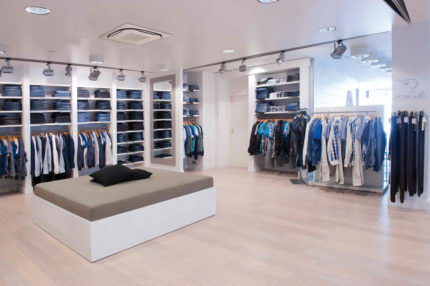
Industrial group includes various modifications of ducted air conditioning systems with a power of over 30 kW. Climate control equipment with similar characteristics is effectively used in shopping and entertainment centers, warehouses, and industrial premises that have strict requirements for temperature and air purity.
When choosing an industrial system, its performance is first taken into account, and only then the attractiveness of the external design.
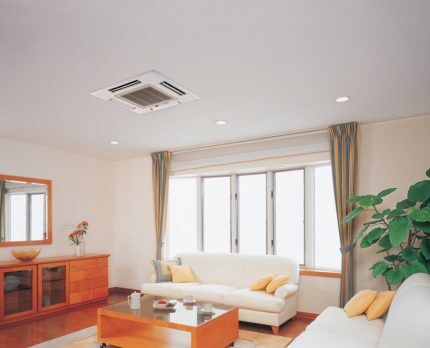
In addition to power, the classification of ceiling systems can relate to a number of characteristics:
- compressor type;
- control system option;
- air filtration level;
- features of the location of the indoor unit.
Each type of equipment differs in functionality and to choose the best ceiling split system, a number of criteria must be taken into account.
Next, we will get acquainted with the features of the most popular types of air conditioners - cassette, duct and floor-ceiling.
Type #1 - cassette ceiling air conditioners
Systems in this category will be the optimal solution for spacious rooms of regular geometry. Such equipment is used when the use of wall-mounted models is ineffective. Cassette systems, like many other air conditioners, are structurally composed of two blocks: external and internal.
The interior can be located anywhere in the room. Air ducts connecting the blocks are often laid in the subceiling space of the suspended ceiling.
The shape of the indoor unit makes it easy to install instead of a decorative suspended ceiling panel.
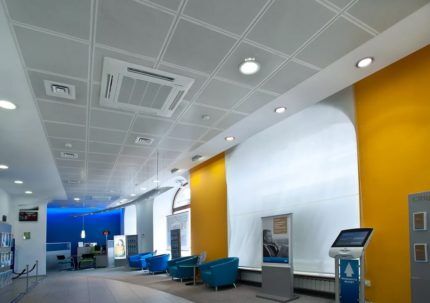
Due to the fact that the internal blocks of cassette systems are integrated into the cells of the Armstrong suspended ceiling, the climate control equipment is practically invisible and does not spoil the interior.
Additional advantages of cassette air conditioners include:
- Uniform distribution of cooled air is achieved due to the fact that the flow from the cassette comes in four directions.
- No drafts, as happens when using a wall-mounted split system.
- Installation of the front panel of the equipment at the same level with the decorative ceiling covering.
- Hidden laying of communications.
The only disadvantage of cassette systems is the reduction in height due to the installation of a suspended ceiling.Therefore, such equipment is used in shopping centers and other buildings where the ceiling height is 3 meters or more.
More details about the pros and cons cassette split systems We talked about it in our other article. Please follow the link and get acquainted in more detail with the features of this equipment.
Type #2 - duct split systems
This type of climate control equipment is similar to cassette air conditioners. As an additional advantage, it is worth noting the possibility fresh air mixing, taken from the street. In fact, such equipment easily copes with the functions of supply and exhaust ventilation.
To prevent the room temperature from dropping below the desired level during the cold season, many models are equipped with equipment for heating the air.
Such designs are relevant for rooms with a large area. The number of air channels can be adjusted according to users' needs. As in cassette systems, indoor units channel systems located in the ceiling space.
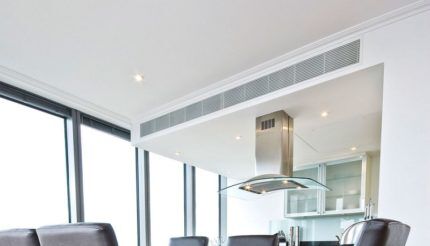
Air ducts are installed in the ceiling space. Their exit is closed with a decorative grille. This is the only element that will be noticeable in the room. The fan and evaporator heat exchanger are located in the interior of the structure, it is completely hidden from prying eyes.
The advantages of duct systems include:
- a minimum number of visible elements that can spoil the interior;
- the ability to maintain the required temperature in one or more rooms;
- constant supply of fresh air.
The disadvantage of ducted air conditioning is the need to create a competent project, the possibility of using the system in rooms with high ceilings.
Type #3 - floor-ceiling devices
Such systems have a wide range of applications. They can be installed on the ceiling, and, if necessary, used on the floor. The indoor unit of floor-ceiling air conditioners is very thin, so it does not make the space feel cluttered. The structure can operate in both vertical and horizontal positions.
Floor-ceiling models are distinguished by wide functionality. They are capable of cooling, heating, purifying air flows, and individual devices help get rid of excess moisture.
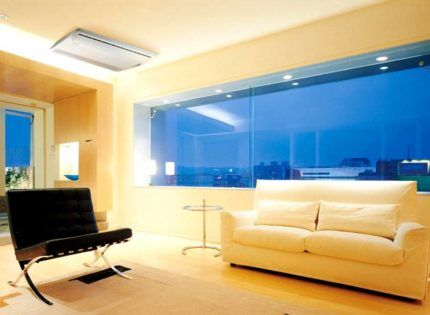
The indoor unit visually resembles a modern radiator. It is equipped with blinds that direct the blown air up or along the ceiling.
Systems equipped with a heat pump or equipped with heaters can heat the air. Devices that have filters in their design can clean convection currents.
Rules for installing ceiling air conditioners
You can install and configure any ceiling air conditioner yourself if you follow the basic rules:
- During the installation process, it is important to maintain cleanliness; no dust or debris should get inside the components and pipeline.
- All connections must be tight. The smallest hole in the air conditioning system can cause incorrect operation of the climate control equipment.
- It is recommended to place the external unit slightly lower than the internal one.
- It’s good if the outdoor unit is in the shade most of the day. Otherwise, the energy costs for operating the air conditioner will be much higher.
- When installing the air conditioner, try to leave the drain pipe as straight as possible and avoid unnecessary bends.
Before starting work, it is important to consider the mounting locations for the internal and external units, and the features of laying communications.
Installation of floor-ceiling system
Let's look at installation using the example of a floor-ceiling model - it is possible to install it yourself. But to install a duct and cassette split system, you will need the help of specialists, as well as professional tools.
Stage #1 - preparation for installation
At the preparatory stage, it is important to think through the order in which installation will be carried out and take into account the various nuances of operating climate control equipment.
All fasteners must have sufficient strength. This is especially important for the external unit, the weight of which can increase significantly as a result of icing and contamination.
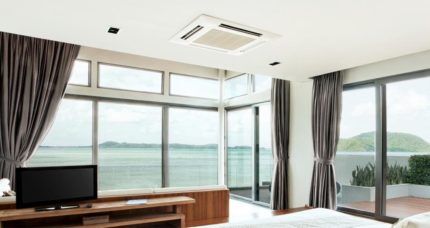
To connect climate control equipment, it is recommended to allocate a separate power supply line. The cross-section of the wire that supplies electricity must correspond to the power of the device with a margin.
Stage #2 - choosing a location for the air conditioner
The presence of two or more blocks in a ceiling split system requires choosing a location for each. When installing climate control equipment in a multi-storey building, a permit will be required.
Article 246 of the Civil Code confirms that a multi-storey building is common property that can be disposed of by all homeowners. Therefore, installation of an external unit without approval is considered a violation.
There are good reasons for this:
- the device hums, disturbing the peace of the neighbors;
- condensation can spoil the external attractiveness of the facade and get onto the balconies and windows located below;
- an external unit can block the view and spoil the view from the window;
- During its installation and operation, there is a risk of cracking of supporting structures and short circuiting of wiring.
Resolution No. 170 prohibits the installation of an external unit without the permission of the management company and the consent of the neighbors. If the air conditioner is installed in a private house or a privately owned building, you can begin installation immediately after purchasing the air conditioning equipment.

When choosing a location for an external unit, it is important to consider the capabilities of supporting structures. The device can be installed next to a window, on a wall, on the balcony or in the attic.
When installing the indoor unit, it is important to determine the approximate direction of air flow. Cooled air should be distributed evenly throughout the room and should not be directed towards the rest area or workplace.
Stage #3 - installation of indoor and outdoor units
The installation of a floor-ceiling split system begins with fastening the indoor unit.
In this case, the following work order is observed:
- Measurements are taken from the block.
- There is a steel mounting frame on the ceiling; compliance with the horizontal and vertical is checked using a level.
- The points where the fasteners will be placed are marked.
- Using a hammer drill, holes are made in which the dowels are fixed.
- The mounting panel is fixed to the ceiling, and the indoor module is fixed to it.
During the work process, it is important to check the compliance of the planes with the level. If there are distortions, condensation may accumulate in the pan.
The outdoor unit is mounted on the street side. Its weight is about 20 kg or more. To cope with the task, at least two installers are involved in working at height.

The procedure for installing the external module is similar to installing the internal one:
- Marking the external wall.
- Creating holes, installing anchor bolts.
- Attaching brackets to the anchors that will hold the device.
- Checking the quality of installation of the frame, hanging the external unit on it.
When the outdoor module needs to be installed on the third floor or higher, you should turn to climbers.
Stage #4 - laying air conditioner communications
The external and internal units are connected by a communications system, which includes copper tubes for the movement of refrigerant and electrical wires. Additionally, a drainage system is installed to remove condensate. It is important to select all elements correctly, arrange them, and securely fasten them.
Since the ceiling air conditioner has high energy consumption, a separate line is allocated for it, and a circuit breaker is installed. The cable cross-section is selected based on the manufacturer’s recommendations specified in the instructions for the device.
To create the pipeline, the following activities are carried out:
- sliced pipe cutter copper pipe of the required length;
- the finished piece is bent without kinks with a maximum radius of 10 cm, for which you can use pipe bender;
- the pipeline is assembled;
- polyurethane foam thermal insulation is put on the pipe;
- the route is laid in a groove and fixed with dowels;
- The integrity and tightness of the assembled pipeline is checked.
To pass the route through walls and ceilings, plugs must be installed at the ends of the pipes.
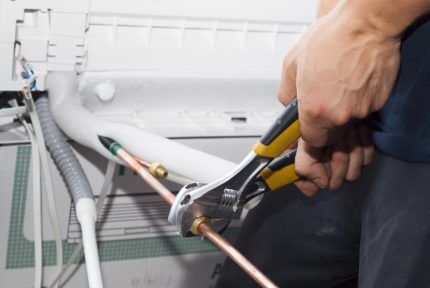
The drainage channel is formed from a piece of reinforced plastic tube. It connects to the sewer, but this is not the most popular method. More often drainage channel taken outside.
Stage #5 - checking system functionality
Before starting the air conditioner, residual air and moisture are removed from the system. The procedure is called vacuuming. To do this, use a vacuum pump or charge the refrigerant with a slight excess. Freon is released from the external module, and air leaves the system with it.
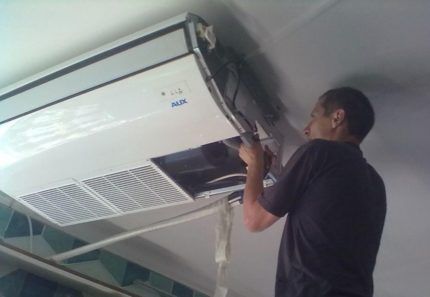
Testing the performance of the air conditioner is carried out in the following order:
- the machine turns on, power is supplied;
- the system automatically enters test mode;
- The operation of the air conditioner is checked for cooling and heating.
If the system does not fail, cooled air spreads evenly throughout the room, you can seal the holes, clean the room, and enjoy the long-awaited coolness.
Setting up a ceiling air conditioner
The main task of an air conditioner is to keep the room cool. As additional functions it can be offered heating, cleaning, air drying, ventilation.
Setting the ceiling air conditioner to cold performed using the control panel. Most often it is indicated by a snowflake icon or the mark "cool".
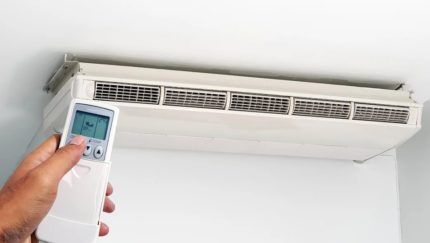
Using the remote control, you can easily change the temperature to which the air will be cooled and the direction of its movement. It is best to set the blinds so that the cold flow moves along the ceiling and is not directed at the people in the room.
When setting the settings, please note that the user can set individual parameters for the operation of climate control equipment or choose automatic mode.
Conclusions and useful video on the topic
To install a ceiling air conditioner yourself, you must have professional equipment and specific skills. The videos presented below will help you choose the best option for climate control equipment and will tell you in detail about the installation process.
The video will tell you about the advantages of a cassette air conditioner:
Step-by-step instructions for installing the ceiling system:
Installation of the ceiling system and its configuration require compliance with building codes, specific knowledge and skills.If there are errors during installation, difficulties during operation cannot be avoided. Therefore, to install an air conditioner, they most often turn to specialists from a company that provides such services. Especially if climate control equipment needs to be installed on the third floor and above.
Do you have experience installing a ceiling air conditioner and would you like to tell other users about the main nuances? Share your tips in the comments. If you are still in thought and don’t know whether to install it yourself or if you still have questions about its installation, ask our specialists and other visitors to our site - the feedback block is located below.




We also need to find a place for the split system so that it doesn’t interfere with the ceiling lights.